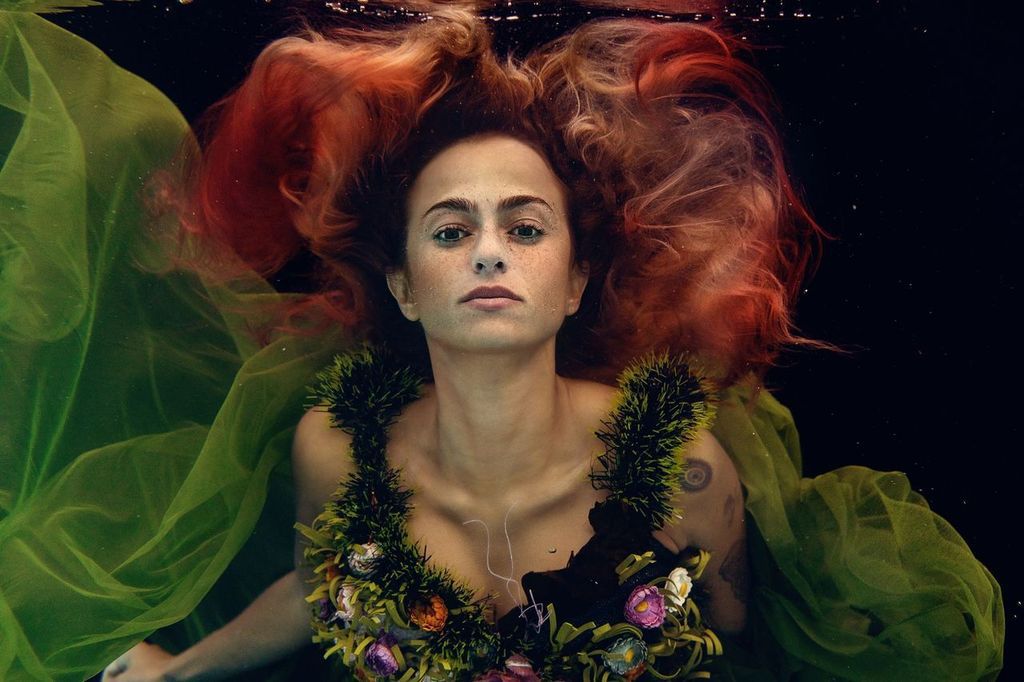Groundbreaking Workshop on AI and Technology-Facilitated Gender-Based Violence at AWiM24
Trending
Sunday May 25, 2025
Trending

Sara El Laithy always loved the sea. But it wasn’t until 2016 that she became a mermaid. In fact, she is considered to be Egypt’s first mermaid. As a child, she was not just drawn to the water, but to the world teeming with marine life meters below. El Laithy wanted to play a real part in protecting the environment. Malak Sallam fostered that same respect for the sea. Having grown up by the sandy beaches of Sharm-el- Sheikh, the ravages of pollution were painful to her. It would be years before she became a mermaid herself, soon combining her job with activism.
Both el Laithy and Sallam discovered their passion through different paths, years apart from each other. They weren’t just eager to tap into their self-expression, but to raise environmental awareness. Once the tails entered the picture everything started coming together.
El Laithy’s love for animals and nature started as a child. And when she made it to university, her environmental passion only grew. After graduating, she went straight to looking for a job at an NGO and started first by working with dolphins. But while she connected with the natural world every day, she felt the pull of an old childhood dream.
“Since I was a child, I was obsessed with the idea of the Little Mermaid. I would pray I’d wake up with a tail because for me the sea, in general, is so mesmerising… It takes your breath away. You feel very different when you’re underwater. It’s a completely different universe that no one really appreciates,” she said fondly.
As she grew older, she almost abandoned her mermaid hopes completely. But upon discovering that professional mermaids existed in other countries, El Laithy was determined to be a mermaid too. After a trip back from Hurghada in 2015, she decided she needed a tail. Dismayed by the prices online, she instead made one herself. El Laithy set off on what proved to be a labour of love. “It took me about a year and a half to make my first tail which is the blue one. And I use it until now, even though obviously, it needs a lot of maintenance.”
Now El Laithy has made a name for herself mermaiding. She has also committed to her activism plans. By working with several organisations such as Blue Odysea, she has participated in beach-side clean-ups, virtual and face-to-face campaigns, and of course, educating children. El Laithy now even has a school, The Mermaid Club and runs it alongside co-founder Hamis Khaled.
Sallam is currently in Spain, but whenever she’s back home in Egypt, she’s teaching mermaiding with the Mermaid Alliance. It all started when a friend of hers suggested a job at the organisation. Before Sallam knew it, she was teaching younger kids how to swim in tails and providing environmental lessons while walking along the shore or swimming. Her love of the ocean and teaching children were being used for something she never expected.“We’d educate younger kids and teenagers on how to swim in a tail or to do new tricks. And it was first during COVID. So we wanted it to be kind of like, accessible to everyone. That’s why we started taking videos.”
Mermaiding is something most Egyptians still have not heard of. “It’s funny, because whenever somebody asks me what I work as and I say ‘a mermaid’, they just think I’m joking. And they’re like ‘You just swim with the little fishies? ‘You’re not there just looking pretty?’ It’s a lot more than that; it’s about putting yourself out of your comfort zone. Not everybody will get into a tail, and try to swim with legs stuck together,” Sallam said.
Mermaiding requires immense self-discipline and bodily awareness. Though young students are mostly expected to learn the basics and have fun, professional mermaids hosting events are more likely to focus on holding their breath and being graceful all while keeping audiences captivated.
El Laithy also shares that same belief about the drive required to be a mermaid.
But with students, it’s the love for learning that matters most. Mermaiding comes most naturally to children unaffected by the self-consciousness of adults. Still, she maintains that at the end of the day, it’s’ about wanting to just be yourself and age isn’t always a barrier. She sometimes sees mothers who are excited to swim in tails with their kids, and older adults even try it, such as one woman in her 50s. El Laithy believes we should not be shocked by these examples since mermaiding is something that many women would be excited to explore if given the chance. “A woman is a woman and expression is expression,” she added. Mermen certainly exist as well and kids are less conscious of gender expectations, but mermaiding remains more popular among girls and women.
Reactions from the general public can sometimes be more mixed. El Laithy recalls reading the comments of one news article earlier in her career. “Some comments would say ‘She’s amazing- good for her.’ but then little cultural parts would come out like ‘She’s wearing a bikini!”’
El Laithy is not as affected by sour comments these days. Her energy is mostly directed towards swimming and environmental activism.
El Laithy first began teaching kids mermaiding as part of the company Blue Odysea, but this year she’s dedicated to doing so through her academy.
”But in the first part of every class, I have to give a small introduction about marine life. I try to inspire them to actually love these animals,” she explained.
Only after nurturing that awe for the environment does the mermaiding truly begin.
El Laithy also pointed out that from experience diving over the years, she has certainly seen the effects of plastic pollution progress. The severity of the situation hit her around 2016. “I never realised that plastic could be this much of an issue until I started to see it everywhere”
Divers and conservationists tend to have the unique opportunity to see environmental changes take their course. To learn more about the effects and awareness of invasive practices, AWiM spoke to Dr Mahmoud Hanafy, Scientific Advisor at the NGO Hurghada Environmental Protection & Conservation Association (HEPCA).
“Marine life population change is noticed because of the overfishing, especially since the Red Sea is not a valuable fishing ground, due to the low water fertility and productivity,” Hanafy said.
Hanafy also noted that social media and sharing videos of the environment can promote more passion and interest from the general public. “We also use these channels to show how blessed we are here in Egypt with unique natural resources, especially The Great Fringing Reef of the Egyptian Red Sea which can be the hope for all corals and biodiversity in the whole world.”
For many environmentalists, the media can be a challenging tool. Sallam’s own journey of mermaiding is to treat it not just as an enjoyable activity, but also as a way to share meaningful messages about both the environment and self-expression.
She has seen people develop a love for the sea by getting to experience it themselves. Children are the easiest to teach because these unique lessons make up for the lack of environmental awareness in the formal education system. Children, Sallam maintains, are excited to learn and share their knowledge with others.
“They go back to their parents, and if they see something that’s not right, they’re gonna say, ‘Mom, let’s try and do this differently.’ And sometimes, of course, the parents do join us in the sessions,” she said.
Using the media to get the message across requires careful planning and realistic expectations.
“We just don’t want it to just be looked at from an entertainment point of view, but also in a way that’s educational. At the end of the day, the algorithm is the one that decides whether or not what you’re trying to portray is going to reach a lot of people so, I think we just stick to what we believe in, and what we think is going to make the world better.”
This article is part of the African Women in Media (AWIM) Graduate Trainee Programme in collaboration with Fojo Media Institute.
We’re not gonna spam. We’ll try at least.

Copyright 2020. African Women In Media
Copyright 2020. African Women In Media
Recent Comments